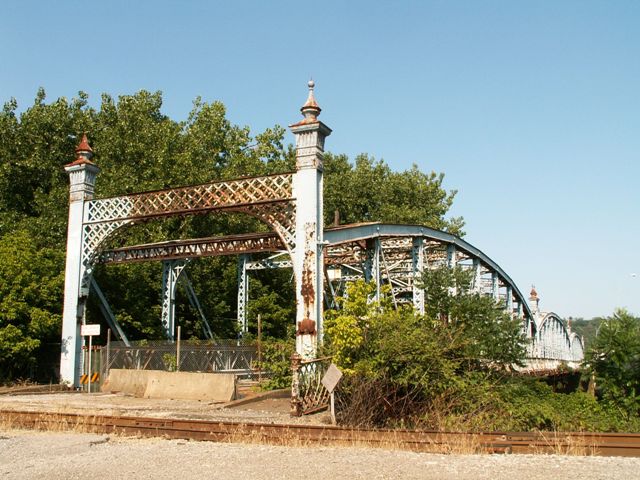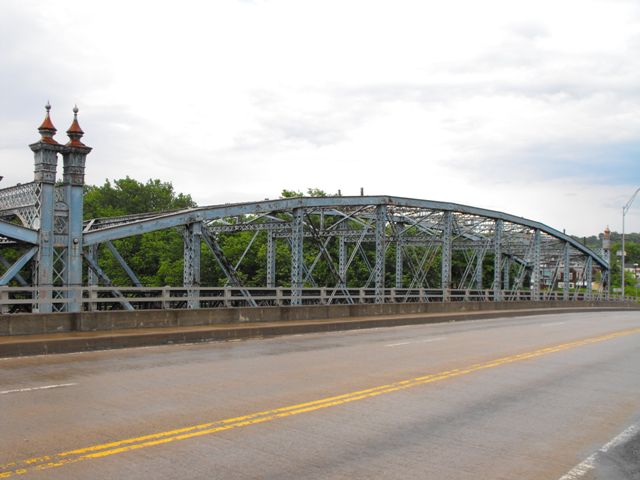We Recommend:
Bach Steel - Experts at historic truss bridge restoration.
BridgeHunter.com Phase 1 is released to the public! - Visit Now
Bridgeport Bridge
Wheeling and Belmont Bridge

Primary Photographer(s): Nathan Holth and Rick McOmber
Bridge Documented: July 4, 2006, and Summer 2009/2010
Bridgeport and Wheeling: Belmont County, Ohio and Ohio County, West Virginia: United States
1893 By Builder/Contractor: Wrought Iron Bridge Company of Canton, Ohio
1987
209.0 Feet (63.7 Meters)
684.5 Feet (208.6 Meters)
32.25 Feet (9.83 Meters)
3 Main Span(s)
35A031

View Information About HSR Ratings
Bridge Documentation
This bridge no longer exists!
This bridge's song is:
View Archived National Bridge Inventory Report - Has Additional Details and Evaluation
View Historic American Engineering Record (HAER) Documentation For This Bridge
HAER Drawings, PDF
This unique and nationally significant historic bridge was wastefully demolished for no reason by West Virginia Department of Highway September 12, 2011
View The 1949 Rehabilitation Plans For This Historic Bridge
View the Adverse Effect Finding For The Planned Demolition Project
Demolition: An Unforgivable Atrocity
Since its founding in 2003, HistoricBridges.org has witnessed bridges of unbelievable historic significance and preservation potential be destroyed. Despite this, the demolition of the Bridgeport Bridge likely ranks in the top 10 worst atrocities against historic bridges. This bridge was demolished for no reason. A replacement bridge had already been built years ago and this bridge stood out of its way on old alignment. The bridge demolition did not make room for any planned construction work. It did not improve the quality of life for anyone. While this bridge's floorbeams were severely deteriorated, and there was significant deterioration in other places, this bridge could have and should have been restored. This bridge was demolished shortly after the tragic floods from Hurricane Irene had damaged or destroyed several historic covered bridges in Vermont and other states. As those states mourned the loss of those bridges and some made plans to repair those damaged bridges, West Virginia was purposely destroying this priceless historic metal truss bridge. This contrast demonstrates the ridiculous lack of balance in the United States where covered bridges are always preserved and metal truss bridges are rarely preserved. This lack of balance is unacceptable and unfair, and is why HistoricBridges.org has countered this imbalance by prohibiting the inclusion of any covered bridges on the Bridge Browser. The Bridgeport Bridge was ten times as important as the average covered bridge, because of its rare design, aesthetic treatment, and surviving original materials. There is no other bridge in the country that has the aesthetic details of this bridge. It was the last surviving example of a large-scale bridge built by the most prolific pre-1900 bridge company in the country, the Wrought Iron Bridge Company of Canton, Ohio. The demolition of this bridge demonstrates that both West Virginia Department of Highways and the City of Wheeling do not care for the heritage of their state and city. While it may be possible to point to other preservation projects in the state, some bridges are so sufficiently rare and significant that they should be preserved at all costs and no amount of preservation elsewhere can excuse the demolition of such bridges.
It is not known how many people visualize West Virginia as a destination for a vacation or a choice state in which to live. However choosing to blindly annihilate nationally significant historic bridges will undoubtedly reduce the quality of life in West Virginia and ultimately decrease the number of people who want to visit or live in West Virginia. While as mentioned historic metal truss bridges are frequently not given the attention they deserve there is a rapidly growing number of people who have an interest in visiting historic metal truss bridges. As states with covered bridges today reap the benefits of heritage tourism that those bridges bring, those states and cities that choose to preserve their historic metal truss bridges will reap similar benefits in the years to come. In contrast, those states which have chosen to demolish their historic bridges will not reap those benefits.
Turning The Spotlight From Wheeling's Suspension Bridge For A Moment
This bridge is located in Wheeling, which is noted for its preserved Wheeling Suspension Bridge, that, like wooden covered bridges, is getting all the attention, when some of the attention should be shifted to other historic bridges. The Wheeling Suspension Bridge is a bridge whose historic significance is without compare, and as such it is an important bridge to note. But there is a classic historic bridge discrimination event unfolding in Wheeling. Quite simply, the problem is Georgia Street Bridge, and more importantly the Bridgeport Bridge. While maybe not a pre-Civil War bridge, these stunning metal truss bridges are indeed historically significant for their length as well as their design and age. Each are nationally significant as extremely large and rare examples of pre-1900 bridge construction. In particular, the Bridgeport Bridge has unparalleled design and significance. It is the last remaining landmark-sized bridge known in the United States built by the prolific and important Wrought Iron Bridge Company of Canton, Ohio. This is to say nothing of its beauty, as an ornate mastery of engineering. Its complex geometric beauty formed by its Parker truss configuration, coupled with decorative finials, portals, and railings create a bridge that is a work of art. The Georgia Street Bridge is perhaps not as large and imposing as the Bridgeport Bridge, but as a pin connected Pennsylvania truss also with ornate portal decorations, it is also a remarkable bridge. If these two bridges could be restored and promoted as attractions, it would turn Wheeling into an unparalleled historic bridge destination, and would also allow the town to continue to be a beautiful place for residents. The Wheeling Suspension Bridge is the beginning of a preservation success story for Wheeling, but it should not be the end of the story! The demolition of either or both of Wheeling's two truss bridges would mark a huge loss for the historic bridge community, and would represent a huge loss for Wheeling.
The Bridgeport Bridge
This bridge has the look of a European bridge to it, with its extremely ornate design, and its unusual vertical end posts.
West Virginia plans to demolish this bridge. The City of Wheeling has shown a striking and disappointing lack of interest in preserving this historic bridge. How can a city stand idly while an irreplaceable historic bridge that has no comparison anywhere in the country is destroyed? This bridge could and should be restored for non-motorized use. Yes, the bridge has some terrible deterioration, and the bridge's floorbeams and other flooring system elements are extremely deteriorated. However, given that these portions of a bridge are often replaced in a rehabilitation, this should not be a concern. The trusses and themselves are all that are needed for preservation. There is nothing apparent that suggests that the bridge could not be restored.
Information and Findings From Ohio's Historic Bridge InventorySetting/Context The bridge is closed to traffic (ca. 1992). A new parallel bridge has been built to the south of the old bridge. The bridge is located in a setting with a mix of late 19th to late 20th century commercial and residential development between Bridgeport, OH and West Wheeling, WV (Wheeling Island). A rail line crosses at grade at the west end of the bridge. Beyond that OH Route 7 is carried on a viaduct over US 40. Physical Description The 3 span, pin-connected Parker thru truss bridge has been strengthened by threading Bailey trusses through the thru trusses to relieve them of live load. In the process, the original built-up floorbeams were cut down or removed to make space for the Bailey trusses. The bridge has eyebar lower chords and diagonals, except for the lower chords in the end panels which are built-up sections from angles and lacing. The upper chords are built-up box-shaped sections with cover plate and lacing. The cantilevered sidewalks are supported on built-up lattice girders with curvilinear bars and decorative, cast-iron end posts. The built-up, vertical end posts of each span have decorative sheet-metal lozenges. The posts extend above the upper chord to support arched lattice portal bracing. Each post is topped by an elaborate finial shaped from sheet metal. The gap between the end posts of adjacent spans is filled with decorative lattice work and sheet-metal cutouts. Integrity Flooring system compromised by removal of original floorbeams. Loss of original fabric from corrosion and loss of some architectural features (parts of finials, sections of railing, etc.) Summary of Significance The 1893 Parker thru truss bridge is the oldest
example of its type/design in the Ohio inventory and among the most
architecturally elaborate examples of any metal-truss bridge in the
region. It was fabricated in 1893 by the Wrought Iron Bridge Company of
Canton, Ohio, for the Wheeling-Belmont Bridge Company and was originally
a private toll bridge. The bridge was bought by the State of West
Virginia and the tolls removed prior to 1952. The bridge is historically
associated with the Old National Road/US 40 and is located in the
Wheeling Island Historic District, WV. The bridge is in WV jurisdiction,
which extends to the west bank of the river. According to WVDOT, the
Bridgeport Bridge has been cleared for demolition and is scheduled to be
removed in 2009. The bridge was listed as a contributing resource to the
Wheeling Island Historic District in 1992 about the time the bridge was
closed to traffic and bypassed. Supporting documentation provided by
WVDOT as attachments D and E. The bridge was surveyed in ODOT's prior
metal-truss inventory (ca. 1981-83, survey form located), but it does
not appear that it was scored or evaluated for eligibility at that time.
Justification The pin connected thru truss bridge is one of 13 extant examples of bridges with polygonal upper chords and/or subdivided panels in the state that date from 1888 until 1923. It is of moderate significance given that the numbers in the population. Bridge Considered Historic By Survey: Yes |
![]()
Photo Galleries and Videos: Bridgeport Bridge
2006 Documentation
Original / Full Size PhotosA collection of overview and detail photos. This gallery offers photos in the highest available resolution and file size in a touch-friendly popup viewer.
Alternatively, Browse Without Using Viewer
![]()
2009-2010 Documentation
Original / Full Size PhotosAdditional overview and detail photos. This gallery offers photos in the highest available resolution and file size in a touch-friendly popup viewer.
Alternatively, Browse Without Using Viewer
![]()
2006 Documentation
Mobile Optimized PhotosA collection of overview and detail photos. This gallery features data-friendly, fast-loading photos in a touch-friendly popup viewer.
Alternatively, Browse Without Using Viewer
![]()
2009-2010 Documentation
Mobile Optimized PhotosAdditional overview and detail photos. This gallery features data-friendly, fast-loading photos in a touch-friendly popup viewer.
Alternatively, Browse Without Using Viewer
![]()
Rainy Day Visit
Additional overview and detail photos. This photo gallery contains a combination of Original Size photos and Mobile Optimized photos in a touch-friendly popup viewer.Alternatively, Browse Without Using Viewer
![]()
Maps and Links: Bridgeport Bridge
This historic bridge has been demolished. This map is shown for reference purposes only.
Coordinates (Latitude, Longitude):
Search For Additional Bridge Listings:
Bridgehunter.com: View listed bridges within 0.5 miles (0.8 kilometers) of this bridge.
Bridgehunter.com: View listed bridges within 10 miles (16 kilometers) of this bridge.
Additional Maps:
Google Streetview (If Available)
GeoHack (Additional Links and Coordinates)
Apple Maps (Via DuckDuckGo Search)
Apple Maps (Apple devices only)
Android: Open Location In Your Map or GPS App
Flickr Gallery (Find Nearby Photos)
Wikimedia Commons (Find Nearby Photos)
Directions Via Sygic For Android
Directions Via Sygic For iOS and Android Dolphin Browser
USGS National Map (United States Only)
Historical USGS Topo Maps (United States Only)
Historic Aerials (United States Only)
CalTopo Maps (United States Only)





